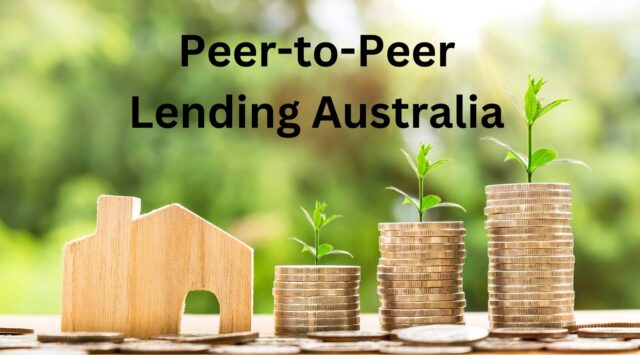The question many Australian individuals and small businesses are asking is, “does peer-to-peer lending still work in Australia?”
The answer is yes; peer-to-peer lending is still viable in Australia. In fact, it has become one of the popular alternatives to traditional banking systems as people seek to avoid the additional cost and scrutiny that comes with bank loans.
This article discusses peer-to-peer lending in Australia and how you can leverage it as an alternative funding source for personal or business needs.
What is Peer-to-Peer Lending?
Peer-to-peer (P2P) lending is a form of financial lending where individual borrowers connect directly with investors or lenders, bypassing traditional financial institutions. It involves an online platform serving as a marketplace where borrowers can request loans and investors can choose to provide them.
Investors, often individuals looking to diversify their investment portfolios, can browse and pick loans to fund based on the borrower’s risk profile, loan purpose, and expected returns.
How Peer-to-Peer Lending Works
In P2P lending, individuals or businesses needing funds apply for a loan through a P2P lending platform. They provide detailed information about the amount they wish to borrow, the purpose of the loan, their credit history, income, and other relevant details.
The P2P platform assesses the borrower’s creditworthiness using the information provided. If the borrower’s application is approved, their loan request is listed on the P2P lending platform.
Now, investors interested in giving out loans browse the listings to fund a loan that matches their risk and return expectations.
Once the borrower receives the funds and starts the repayment, the lending platform deducts their fees and pays the investor the agreed interest and principal.
Benefits of Peer-to-Peer Lending
Whether you’re resorting to P2P lending for your personal or business financial needs, there are many benefits it offers you. Here are some of them:
Alternative Funding
Traditional banks and other formal financial institutions have stringent requirements for lending money to individuals and businesses. This makes it difficult for many people to access loans when needed.
P2P lending offers you access to finance that you may not have been able to get from traditional banking channels. Even if your credit score is low, or you don’t have the collateral to access the funds you need from a traditional bank, P2P lending is a reliable alternative.
Flexible Terms
P2P lending offers you more flexibility than traditional bank lending. You can choose from a range of loan amounts, repayment periods and interest rates that meet your needs and financial situation.
This flexibility lets you plan your finances, ensuring you don’t miss out on repayment obligations.
Competitive Interest Rates
Most P2P lending platforms operate online and don’t incur as much overhead as brick-and-mortar banks. This enables them to pass the cost savings to borrowers in the form of lower interest rates.
Simple Loan Process
One of the key benefits of accessing funds from P2P lending platforms is that they have a streamlined and efficient loan application process.
Unlike traditional banks, P2P lenders don’t present stringent loan application requirements. You can complete the entire loan application process online. If your application is approved, the funds will immediately be disbursed to your account.
Also Read: Microlending Across the Globe: Fast Facts and Statistics
Drawbacks of P2P Lending in Australia
P2P lending has drawbacks you must consider before applying for or accepting a loan. Here are some of them:
Lower Loan Amounts
Unlike traditional banks, P2P loans are offered by individuals or businesses with limited investment funds. Therefore, they offer loans up to a set limit, which might not be enough to cover your needs.
No Guarantee of Funding
There’s no guarantee you’d get funding from P2P lending platforms, as they, like banks, assess their risk exposure in offering you a loan. Your application can be denied based on your credit history, income level, and other factors.
Higher Interest Rates
While they sometimes offer lower rates than traditional banks, P2P lenders can also provide loans with ridiculously high rates. This is usually because of the credit risk involved, as many borrowers have less-than-perfect credit histories and might not repay loans.
Where Can You Get Peer-to-Peer Loan in Australia?
Many peer-to-peer lending platforms facilitate loans for individuals and businesses in Australia. Here are some of the most popular:
SocietyOne
SocietyOne is one of Australia’s biggest and most popular P2P lending platforms. It provides borrowers loans to consolidate their debts, make home improvements, travel or handle some business expenses.
You can access loans ranging from $5,000 to $70,000 and get a flexible repayment date of 2 to 5 years.
Plenti
Plenti, formerly RateSetter, is another P2P lending platform in Australia. It offers personal loans, green loans, car loans, etc. to Australian borrowers.
You can access loans ranging from $2,000 to $50,000, with 6 months to 7 years terms.
ThinCats
ThinCats is one of the P2P lending platforms in Australia that provides loans for small businesses by connecting them directly with investors.
You can access loans ranging from $50,000 to $2 million to support your business needs.
Also Read: The Best Working Capital Loans for Aussies in 2024
How to Apply for a Peer-to-Peer Loan in Australia
Here’s a simple step-by-step process to apply for a P2P loan in Australia:
Compare Peer to Peer Lending Platforms
The first step to getting a P2P loan in Australia is to research and compare the P2P platforms. As listed above, there are many P2P lending platforms in Australia, such as MoneyPlace, Plenti, Wisr, SocietyOne, etc.
Compare their loan terms, interest rates, fees, eligibility criteria and repayment structures. Also, check customer reviews to know what previous borrowers are saying about them.
In everything, ensure you choose a lending platform that best suits your borrowing needs.
Apply Online
Once you’ve chosen a lending platform, the next stage is the application.
Most Australian P2P lending platforms offer an online application process. Sign up on the platform, complete the online application form, and provide the required information.
This is the stage where you provide your personal and financial information, including your name, address, employment details, income, expenses, and the loan amount you wish to borrow.
Provide Required Documents
Some P2P platforms require you to provide documents to support the information you provided. This is to verify important details like your identity, income, and overall financial situation.
Wait for Loan Approval
Your loan application will be processed once you’ve provided the required information and documents.
If approved, you’d get a loan offer detailing the loan amount, interest rate, loan term, and repayment schedule. Review the loan offer carefully and understand the terms before accepting it.
Immediately after you accept the loan offer, the lending platform will disburse the funds to your account.
Key Questions to Ask When Considering Peer-to-Peer Lending in Australia
Before applying for a P2P loan in Australia, it’s essential to ask the following questions:
What are your repayment schedules?
Understanding the repayment schedules of the P2P lender before accepting the loan is essential. By doing that, you accept only loans that fit your needs and align with your income. This enables you to stay on course with your repayments and not have debts pile up for you.
What are the interest rates and fees?
Most P2P lenders have standard rates for specified loan amounts. However, in some cases, they can allow an investor to request higher or lower interest due to the borrower’s financial information.
Therefore, you must inquire about the interest rates and the fees the platform charges for every transaction.
How does the platform handle defaults and late payments?
Learn about the platform’s reputation for managing defaults and late payments. Also, understand the steps they take to recover outstanding debts.
This information will help you plan your repayments and know what to do when late payment is inevitable.
Conclusion
Peer-to-peer lending remains a viable option in Australia and is gradually becoming a major funding source for individuals and small businesses.
While there are drawbacks, its benefits outweigh them. Before you apply for a loan, ensure you need it and do your due diligence to get loan terms that align with your needs.









